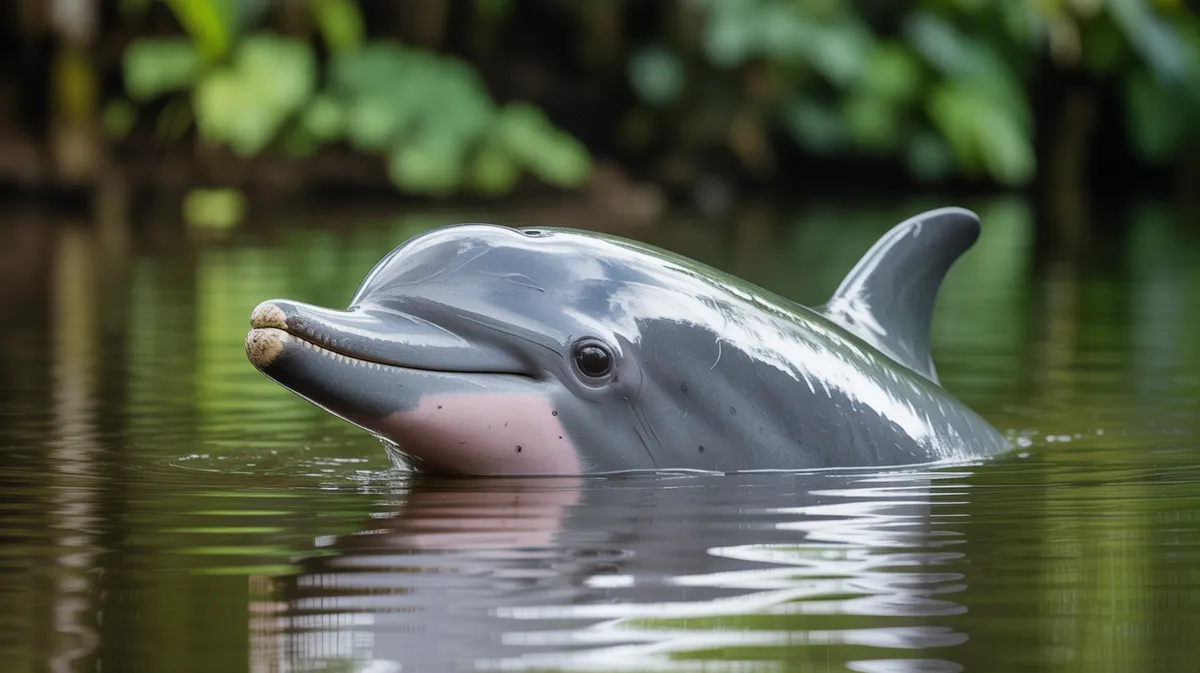
Amazon River Dolphin
Inia geoffrensis

Meet the Amazon River Dolphin
The Amazon River Dolphin, also known as the Pink Dolphin, is a freshwater cetacean native to the river systems of the Amazon and Orinoco basins in South America. Its most distinctive feature is its pink coloration, which intensifies with age and during periods of excitement. These dolphins have long, slender beaks and flexible necks, allowing them to navigate through flooded forests with ease. Exceptionally intelligent, they use echolocation to hunt for fish, crustaceans, and even small turtles. Despite their mystical reputation among local cultures, Amazon River Dolphins face threats from habitat loss, pollution, and accidental capture in fishing gear.
Classification
Mammal
Habitat
Freshwater rivers and flooded forests
Diet
Carnivore
Lifespan
15-30 years
Conservation
Endangered
Weight
85-185 kg
📖Fascinating Facts
Blushing Dolphins
The pink hue of these dolphins becomes more vibrant when they are excited or during social interactions.
Flooded Forest Navigators
During the rainy season, Amazon River Dolphins venture into flooded forests to hunt, using their flexible necks to maneuver around trees.
Diverse Diet
Their diet includes over 50 species of fish, as well as crustaceans and occasionally river turtles.
📋Detailed Description
The Amazon River Dolphin (Inia geoffrensis), also known as the boto, is the largest species of river dolphin, with adult males reaching lengths of up to 2.55 meters and weights of 185 kilograms, while females are generally smaller. Its most striking feature is its variable pink coloration, which ranges from pale gray in juveniles to vivid pink in mature males, a trait thought to be influenced by capillary placement, diet, and scar tissue from social interactions. Unlike marine dolphins, the boto has an unfused cervical vertebrae, granting it remarkable neck flexibility that allows it to maneuver through submerged forest obstacles and tight spaces. Its elongated beak, lined with 25–29 pairs of conical and molar-like teeth per jaw, is adapted for grasping and crushing a diverse array of prey, including over 50 species of fish, as well as crustaceans and freshwater turtles. The dorsal fin is low and ridge-like, aiding navigation in shallow, debris-laden waters. The species possesses small, paddle-shaped pectoral fins and a robust body, both adaptations for agile movement in flooded forests. Amazon River Dolphins are highly intelligent, exhibiting complex problem-solving abilities and sophisticated echolocation skills, which are essential for hunting in turbid waters. Their eyes are small but well-adapted to low-light conditions, and they possess a keen sense of hearing. Socially, they are typically observed alone or in small groups, though larger aggregations may occur seasonally. Their lifespan in the wild is estimated to be up to 30 years, though precise data is limited due to the challenges of long-term monitoring in their habitat.
💡 Did you know?
Despite living in murky river waters, Amazon River Dolphins have excellent eyesight above and below the water surface.
🔬Research & Sources
Wikipedia Summary
The Amazon river dolphin, also known as the boto, bufeo or pink river dolphin, is a species of toothed whale endemic to South America and is classified in the family Iniidae. Three subspecies are currently recognized: I. g. geoffrensis, I. g. boliviensis and I. g. humboldtiana. The position of the Araguaian river dolphin within the clade is still unclear. The three subspecies are distributed in the Amazon basin, the upper Madeira River in Bolivia, and the Orinoco basin, respectively.
Last Modified: 6/2/2025
🎭Behavior & Social Structure
Amazon River Dolphins are generally solitary or found in small, loose groups of 2–4 individuals, though temporary aggregations of up to 15 may form in areas of abundant food. They are diurnal, with peak activity during early morning and late afternoon. Their hunting strategy relies heavily on echolocation, emitting a series of clicks to locate prey in the often murky river waters. Botos are opportunistic feeders, preying on a wide variety of fish, including catfish, piranhas, and characins, as well as crustaceans and turtles. They have been observed using their flexible necks and elongated beaks to probe into submerged vegetation and crevices. Cooperative hunting is rare, but individuals may follow fishing boats or exploit fish driven by human activity. Social interactions include tactile behaviors such as rubbing and gentle biting, and males are known to display objects (such as branches or clay) during courtship or dominance displays. Vocalizations consist of clicks, whistles, and pulsed calls, which play roles in communication and navigation.
👶Reproduction & Life Cycle
Breeding in Amazon River Dolphins is generally seasonal, coinciding with the flooding cycle of the Amazon basin. Mating typically occurs during the low-water season (May–June), with births peaking during the high-water season (July–September), ensuring abundant food for lactating mothers. Gestation lasts approximately 11–13 months. Females give birth to a single calf, which measures about 80 cm in length and weighs around 12 kg at birth. Calves are born with a gray coloration and remain dependent on their mothers for up to two years, during which they are nursed and gradually introduced to solid food. Parental care is primarily maternal, with little involvement from males. Sexual maturity is reached at 6–7 years for females and 7–10 years for males. The reproductive rate is low, with females typically giving birth every 2–4 years, contributing to the species' vulnerability.
🛡️Adaptations & Survival
The Amazon River Dolphin exhibits several unique adaptations for its freshwater environment. Its unfused cervical vertebrae allow for extraordinary head rotation, facilitating navigation through dense submerged forests. The elongated, narrow beak and heterodont dentition enable it to exploit a wide range of prey, including armored and benthic fish. Reduced dorsal fin size minimizes entanglement in vegetation. Echolocation is highly developed, with specialized fat bodies in the lower jaw (acoustic windows) that enhance sound reception. The species can tolerate significant fluctuations in water temperature and turbidity. Its pink coloration may serve as camouflage among the reddish river sediments or as a signal during social interactions. The ability to survive in both main river channels and seasonally flooded forests (várzea) demonstrates ecological flexibility.
🎨Cultural Significance
The Amazon River Dolphin holds a prominent place in local folklore and mythology. In many Amazonian cultures, the boto is believed to possess supernatural powers, often depicted as a shape-shifter that can transform into a handsome man to seduce women during festivals. Such legends have fostered both reverence and fear, leading to taboos against harming the dolphins. In some regions, however, traditional beliefs have not prevented hunting for bait or medicinal purposes. The boto is also a symbol of the Amazon's biodiversity and is featured in ecotourism initiatives, which can contribute to local economies and conservation awareness.
🔬Recent Research & Discoveries
Recent genetic studies have clarified the taxonomy of Inia geoffrensis, confirming three subspecies and highlighting significant genetic differentiation across river basins. The status of the Araguaian river dolphin (Inia araguaiaensis) remains under investigation, with some evidence suggesting it may be a distinct species. Ongoing research focuses on population monitoring using acoustic surveys and photo-identification, as well as the impacts of mercury contamination on health and reproduction. Satellite telemetry has provided new insights into movement patterns and habitat use, revealing seasonal migrations linked to flood cycles. Conservation programs are increasingly involving local communities in monitoring and protection efforts. Notably, studies on the cognitive abilities of botos have demonstrated advanced problem-solving and social learning behaviors, underscoring their intelligence.
🎥Wildlife Videos

Pink River Dolphins Of The Amazon Rainforest's Hunting Secret | Earth's Great Rivers | BBC Earth
Earth's Great Rivers Embark on the ultimate river voyage down three of the world's most epic rivers – the Amazon, the Nile and the ...
BBC Earth
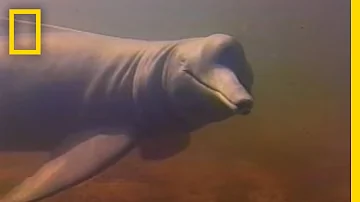
Pink Dolphins? | Weird Nature
About National Geographic: National Geographic is the world's premium destination for science, exploration, and adventure.
National Geographic
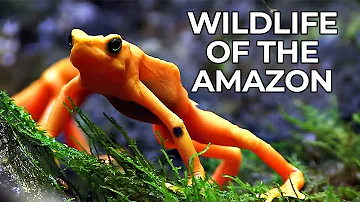
World of the Wild | Episode 1: The Amazon Rainforest | Free Documentary Nature
World of the Wild - Episode 1: The Amazon Rainforest | Wildlife Documentary Watch 'World of the Wild - Episode 2' here: ...
Free Documentary - Nature

Amazon River Dolphins: Pink Freshwater Dolphins That Eat Piranhas
----------- SOCIAL MEDIA https://www.tiktok.com/@animalogic https://www.instagram.com/animalogicshow/ ...
Animalogic
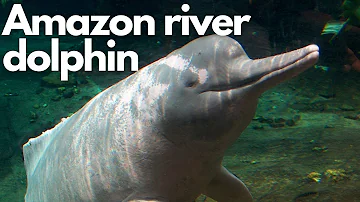
Discovering the Amazon River Dolphin: Nature's Pink Wonder
Dive into the enchanting world of the Amazon River Dolphin, also known as the pink river dolphin! In this captivating video, we ...
World Wonders
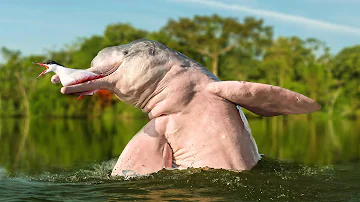
AMAZON RIVER DOLPHIN - Mystical Guardians of the Amazon Rainforest
Embark on a journey through the watery heart of the Amazon rainforest in our enthralling short documentary featuring the ...
BEASTFLIX
🌍Habitat Information
The Amazon River Dolphin typically inhabits Freshwater rivers and flooded forests environments. Amazon River Dolphins have adapted to their environments with specialized features and behaviors.
Primary Habitat:
Freshwater rivers and flooded forests
More detailed habitat information will be available soon.
🛡️Conservation Status
The Amazon River Dolphin is currently classified as Endangered. Conservation efforts are crucial for preserving this species for future generations.
Common Threats:
- 🏠Habitat loss and fragmentation
- 🌡️Climate change impacts
- 🎯Hunting and poaching
- 🏭Human-wildlife conflict
⚠️Threats & Conservation Challenges
The primary threats to the Amazon River Dolphin include habitat degradation from dam construction, deforestation, and waterway modification, which fragment populations and alter river dynamics. Pollution from mercury (due to gold mining), agricultural runoff, and industrial waste poses significant health risks, leading to bioaccumulation of toxins. Incidental capture (bycatch) in fishing gear, as well as deliberate hunting for use as bait in the piracatinga (catfish) fishery, has caused localized population declines. Boat traffic and noise pollution disrupt natural behaviors and increase the risk of collisions. Climate change, resulting in altered flood regimes, further threatens their complex habitat. The IUCN currently lists the species as Endangered, with population trends showing ongoing declines across much of its range. Conservation efforts are hampered by limited enforcement, insufficient data, and the species' wide distribution in remote areas.
🔬Scientific Classification
Scientific Name
Inia geoffrensis
Classification Hierarchy
🔍 About Taxonomic Classification
Taxonomic classification is a hierarchical system used by scientists to classify and organize living organisms based on shared characteristics and evolutionary relationships.
The system moves from broad categories (Kingdom) to increasingly specific ones, with each animal's scientific name typically consisting of its Genus and species.
📝Community Notes
Share your observations and insights about the Amazon River Dolphin with our community of wildlife enthusiasts.
Join Our Community
Sign in to share your observations and connect with fellow wildlife enthusiasts.
Sign In to ContributeNo community notes yet
Be the first to share your observations about the Amazon River Dolphin!
Explore Amazon River Dolphin
Select a tab above to learn more about this amazing animal.
📸Photo Gallery
No photos available for this animal yet.
🌟Discover More Wildlife
Continue your journey of discovery with more fascinating animals from our database
